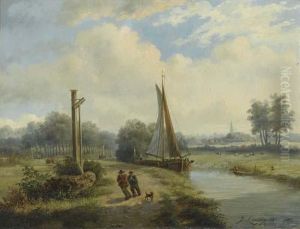Jan Theodor Joseph Linnig Paintings
Jan Theodor Joseph Linnig was a Belgian painter, engraver, and draftsman born on August 24, 1815, in Antwerp. He was part of a family deeply involved in the arts; his father, Willem Linnig, Sr., was a noted painter and engraver, and his brother, Willem Linnig, Jr., was also an artist. Jan Theodor grew up in an environment that was conducive to developing his artistic talents from an early age.
Linnig studied at the Royal Academy of Fine Arts in Antwerp, where he honed his skills in drawing and painting. His early works were primarily religious in theme, reflecting the influence of the Flemish Old Masters, which was typical for Belgian artists of the period. However, as his career progressed, Linnig began to focus more on genre scenes, landscapes, and still lifes that depicted the beauty of the Belgian countryside and its inhabitants' way of life.
In the mid-19th century, Linnig became known for his meticulous engraving work. He was particularly admired for his technical skill in reproducing the works of other artists, a common practice at the time which helped disseminate art to a wider audience. Through his engravings, Linnig contributed to the preservation and promotion of Flemish cultural heritage.
Despite having a less prominent international reputation compared to some of his contemporaries, Linnig was appreciated in his homeland for his commitment to Belgian subjects. He participated in numerous exhibitions, and his work was collected by local art enthusiasts. Linnig's contributions to the Belgian art scene were recognized during his lifetime, and he was a respected member of the artistic community in Antwerp.
Jan Theodor Joseph Linnig passed away on May 16, 1891, in Antwerp. Today, his artworks can be found in the collections of various museums in Belgium, including the Royal Museum of Fine Arts in Antwerp. His legacy is that of an artist dedicated to capturing the spirit of his homeland, contributing to the rich tapestry of 19th-century Belgian art.
